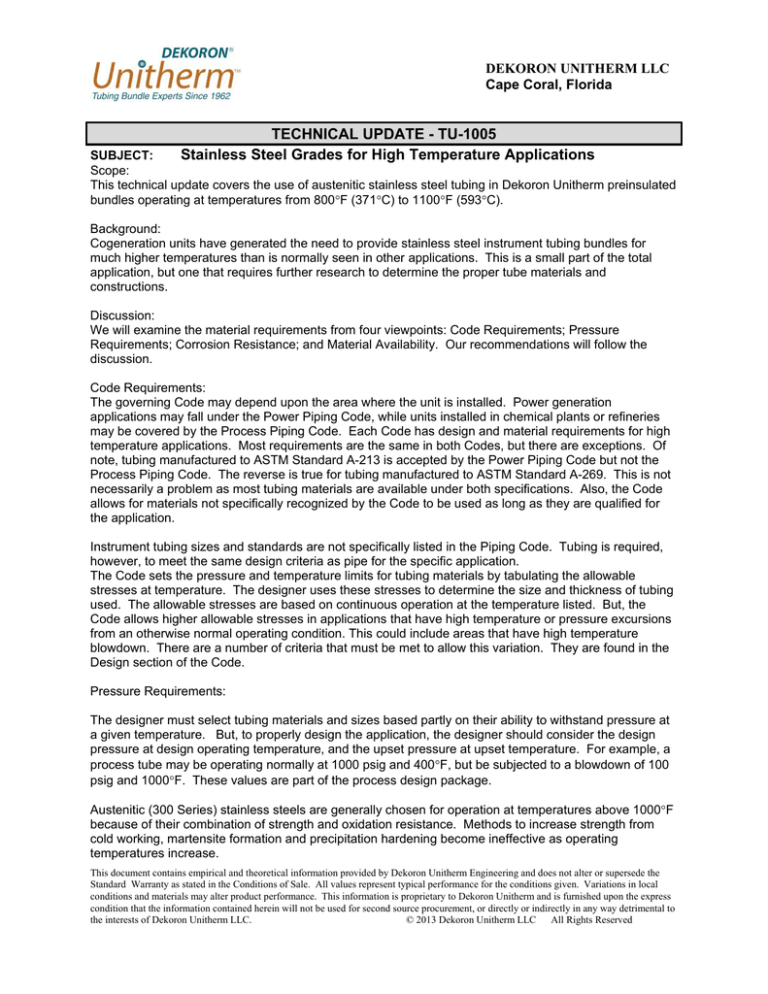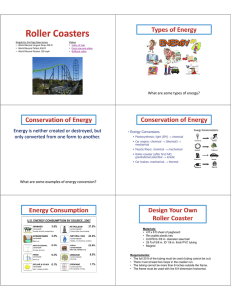
DEKORON UNITHERM LLC
Cape Coral, Florida
TECHNICAL UPDATE - TU-1005
Stainless Steel Grades for High Temperature Applications
SUBJECT:
Scope:
This technical update covers the use of austenitic stainless steel tubing in Dekoron Unitherm preinsulated
bundles operating at temperatures from 800°F (371°C) to 1100°F (593°C).
Background:
Cogeneration units have generated the need to provide stainless steel instrument tubing bundles for
much higher temperatures than is normally seen in other applications. This is a small part of the total
application, but one that requires further research to determine the proper tube materials and
constructions.
Discussion:
We will examine the material requirements from four viewpoints: Code Requirements; Pressure
Requirements; Corrosion Resistance; and Material Availability. Our recommendations will follow the
discussion.
Code Requirements:
The governing Code may depend upon the area where the unit is installed. Power generation
applications may fall under the Power Piping Code, while units installed in chemical plants or refineries
may be covered by the Process Piping Code. Each Code has design and material requirements for high
temperature applications. Most requirements are the same in both Codes, but there are exceptions. Of
note, tubing manufactured to ASTM Standard A-213 is accepted by the Power Piping Code but not the
Process Piping Code. The reverse is true for tubing manufactured to ASTM Standard A-269. This is not
necessarily a problem as most tubing materials are available under both specifications. Also, the Code
allows for materials not specifically recognized by the Code to be used as long as they are qualified for
the application.
Instrument tubing sizes and standards are not specifically listed in the Piping Code. Tubing is required,
however, to meet the same design criteria as pipe for the specific application.
The Code sets the pressure and temperature limits for tubing materials by tabulating the allowable
stresses at temperature. The designer uses these stresses to determine the size and thickness of tubing
used. The allowable stresses are based on continuous operation at the temperature listed. But, the
Code allows higher allowable stresses in applications that have high temperature or pressure excursions
from an otherwise normal operating condition. This could include areas that have high temperature
blowdown. There are a number of criteria that must be met to allow this variation. They are found in the
Design section of the Code.
Pressure Requirements:
The designer must select tubing materials and sizes based partly on their ability to withstand pressure at
a given temperature. But, to properly design the application, the designer should consider the design
pressure at design operating temperature, and the upset pressure at upset temperature. For example, a
process tube may be operating normally at 1000 psig and 400°F, but be subjected to a blowdown of 100
psig and 1000°F. These values are part of the process design package.
Austenitic (300 Series) stainless steels are generally chosen for operation at temperatures above 1000°F
because of their combination of strength and oxidation resistance. Methods to increase strength from
cold working, martensite formation and precipitation hardening become ineffective as operating
temperatures increase.
This document contains empirical and theoretical information provided by Dekoron Unitherm Engineering and does not alter or supersede the
Standard Warranty as stated in the Conditions of Sale. All values represent typical performance for the conditions given. Variations in local
conditions and materials may alter product performance. This information is proprietary to Dekoron Unitherm and is furnished upon the express
condition that the information contained herein will not be used for second source procurement, or directly or indirectly in any way detrimental to
the interests of Dekoron Unitherm LLC.
© 2013 Dekoron Unitherm LLC All Rights Reserved
Technical Update TU-1005
page 2 of 3
The most common steels used are TP 316 (UNS S31600) and TP 316L (UNS S31603). These provide a
good combination of high temperature strength and corrosion resistance. The low carbon grade provides
added corrosion protection as noted later in this report.
Allowable stresses for these materials drop off as the temperature increases. The drop becomes sharp
as the temperature climbs past 1000°F. The table below shows the drop in allowable stress in tension for
metals, as shown in ASME B31.3, Table A-1.
Material
TP 316, A-269
TP 316L, A-269
800°F
15,900 psi
12,400 psi
900°F
15,500 psi
11,800 psi
1000°F
15,300 psi
11,200 psi
1100°F
12,400 psi
10,200 psi
Notes
(14)(26)(28)(31)(36)
(14)(36)
Notes: From ASME B31.3 “Notes for Appendix A Tables”
(14) For use in Code piping at the stated stress values, the required minimum tensile and yield properties must be verified by tensile
test. If such tests are not required by the materials specifications, they shall be specified in the purchase order.
(26) This unstabilized grade of stainless steel increasingly tends to precipitate intergranular carbides as the carbon content
increases above 0.03%. See also para F323.4(c)(2).
(28) For temperatures above 538°C (1000°F) these stress values apply only when the carbon content is 0.04% or higher.
(31) For temperatures above 538°C (1000°F) these stress values may be used only if the material has been heat treated by heating
to a minimum temperature of 1038°C (1900°F) and quenching in water or rapidly cooling by other means.
(36) The specification permits this material to be furnished without solution heat treatment or with other than a solution heat
treatment. With no solution heat treatment, minimum temperature is -29°C (-20°F) unless impact tested.
Put in terms that are more relevant to the designer, the internal design gage pressure for 1/2” OD x
0.049” wall stainless steel tubing based on the above design stresses are as follows:
Material
TP 316, A-269
TP 316L, A-269
800°F
3125 psi
2450 psi
900°F
3050 psi
2300 psi
1000°F
2990 psi
2200 psi
1100°F
2450 psi
1990 psi
Per ASME B31.3; 304.1.2, the lesser of equation 3a or 3b
The allowable stress value for TP 316 stainless steel at 1100°F is valid only for heats where the carbon
content is above 0.04% per Note 28, above. However, the design gage pressure can also be determined
by other methods. One method is to calculate the pressure using 67% of the average stress for rupture
at the end of 100,000 hours at the designated temperature. (B31.3, 302.3.2(d)(5)) Using this stress value
gives a design gage pressure of 2725 psi. As this is higher than the values listed in the table, the table
would be used. There are other several other methods listed in the Code that must be checked. The
design gauge pressure would be the lowest value calculated.
The allowable stress value for TP 316L stainless steel at 1100°F does not carry the note regarding
modification, so it is used as the basis for internal design gage pressure.
A recent addition to the list of materials is the high carbon or “H” grades. Boiler and superheater tubes
manufactured under ASTM Standard A-213 using TP 316H (UNS 31609) are listed as approved
materials in the Power Piping Code. This material has proven long-term service life when used in pipe. It
would also meet the minimum carbon content required in the stress table. There may be some problems,
however, when this material is used in preinsulated tubing applications.
The ASTM A-213 tubing standard was developed for straight, cut lengths of tubing used in boilers, heat
exchangers, and superheaters. The design yield strength is based on a manufacturing process including
tube straightening. If the tubing is purchased unstraightened (as in coils), the design yield strength at
room temperature must be reduced 5,000 psi. This puts TP 316H at the same level at TP 316L. If this
follows throughout the temperature range, then the internal design gage pressure would be the same as
that shown for TP 316L, above.
The higher carbon content in the “H” grade stainless steel will also increase the rate of work hardening.
This can be a special problem for bundles that require multiple layers of insulation. Each pass through
the insulating equipment could increase work hardening. The question may be compounded by the
requirement that “H” grade steels be supplied to the application in the solution annealed condition. This
requirement may preclude any processing on coiled tubing.
Technical Update TU-1005
page 3 of 3
If the tubing is supplied in straight lengths to take advantage of all the properties of the “H” grade
stainless steel, then it must be joined in the field. Many design specifications require socket weld fittings
for tubing used at high temperatures. At this point, the designer must be concerned with the effects of
welding on the high carbon steel. It is generally known that heating stainless steel tubing to welding
temperature will sensitize the steel resulting in loss of corrosion resistance. Improper attention to welding
the high carbon material may also lead to localized stresses that could reduce service life.
Corrosion Resistance:
As noted above, intergranular attack and intergranular stress corrosion cracking can be significant
problems with stainless steel tubes operating at temperatures above 850°F. The problem occurs when
carbides precipitate to the austenite grain boundaries. These areas then become susceptible to
corrosive attack.
If the system is constructed of straight lengths of tubing joined with socket welds, then the most likely
area for corrosive attack is the area least protected.
Two methods readily available to increase corrosion resistance are lowering the carbon content of the
tubing material and reducing the instances of unprotected tubing.
Material Availability:
The recent flurry of high temperature applications has caused designers to look at a number of material
and construction options. Some of these options are to migrate materials and processes used in pipe
applications to relatively thin walled, smaller diameter tubing.
A problem occurs when the tubing manufacturers are called on to fill these requests. The new material
may not process on the existing equipment. A case in point is the request for TP 316H tubing.
The high carbon content in TP 316H causes the material to work harden rapidly. This reduces the
amount of draw and the number of draws allowed before the tubing must be annealed. It also increases
the chance of tube fractures during the drawing process. This increases both the lead times and the cost
of the tubing.
At the time of this report one major seamless tubing supplier has determined that they are unable to
efficiently produce the tubing sizes and wall thicknesses required for cogeneration applications, and have
declined to bid on any requests for TP 316H tubing.
Dekoron/Unitherm Recommendation
After discussions with suppliers and customers, and review of the Codes, Standards, and information
available to us, Dekoron/Unitherm feels that the high temperature bundles for cogeneration applications
can be best provided using seamless type TP 316L austenitic stainless steel tubing in coils. This material
and construction can provide a bundle that meets the pressure and temperature requirements of the
application and is well respected in the industry.
References:
1. ASME B31.3-1999 Process Piping Code”, The American Society of Mechanical Engineers, New York,
1999
2, M. L. Nayyar (ed), “Piping Handbook”, 7th Edition, McGraw-Hill, New York, 2000
3. W. H. McAdams, “Heat Transmission”, McGraw-Hill, New York, 1942
4. J. H. Hoke, “Mechanical Properties of Stainless Steels at Elevated Temperatures”, Metals Handbook,
The American Society of Mechanical Engineers, New York


